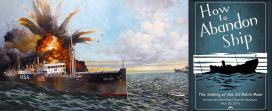SS Robin Moor Story Told in “How to Abandon Ship,”
KINGS POINT, N.Y., May 16, 2016 – The American Merchant Marine Museum at the U.S. Merchant Marine Academy (USMMA) at Kings Point opens its most ambitious display to date, “How to Abandon Ship,” The SS Robin Moor Story, on Friday.
The Robin Moor story is quite simple. On May 21, 1941, the American freighter Robin Moor was steaming from New York City to Cape Town, South Africa. The United States had not entered World War II, and the ship sported the large white letters USA and a large American flag painted on its hull. These were called neutrality markings, and announced to all belligerent nations that this ship had no part in the war.
Before dawn, a German U-boat stopped the American ship, and after speaking with the freighter’s officers, announced the Robin Moor would be sunk, and gave the crew and passengers a few minutes to launch the ship’s lifeboats. The submarine then torpedoed and shelled the hapless freighter, and departed, leaving four lifeboats with some eight passengers and thirty-eight merchant seamen to fend for themselves in the middle of the ocean.
Three of those lifeboats were picked up after fourteen grueling days, and the survivors taken to Cape Town, South Africa. The fourth lifeboat was picked up after eighteen days and taken to Recife, Brazil. Remarkably, nobody died in the incident, although one young mariner tragically committed suicide while on his way home.
This is, however, much more than a lifeboat survival story. When news of the sinking reached the United States, the American public was baffled. Why would anyone sink a harmless freighter? Who had done this? Many correctly assumed it was a German submarine that sank the Robin Moor, but no one could understand why it had committed this outrage. The American government called for calm, and studied the situation by questioning the survivors. Finally, on June 20, President Franklin D. Roosevelt was ready to speak in a radio address. He identified this act as perpetrated by a Nazi U-boat, and castigated the actions of the submarine’s commander as “outrageous and indefensible,” and an act of piracy for which he held Germany responsible. But Roosevelt also stopped short of asking Congress for a declaration of war.
In the months to come, the American government and public did not forget the Robin Moor incident. As Germany repeatedly committed acts of aggression and American commercial and naval vessels, Americans repeatedly invoked the Robin Moor as they debated whether to go to war. That answer was questioned for them when the Imperial Japanese Navy bombed Pearl Harbor on the morning of December 7, 1941.
Beyond the question of declaring war, the Robin Moor was very much a story about people. These include merchant mariners like John Banigan, the Robin Moor’s third officer, who so skillfully navigated his lifeboat almost to the coast of Brazil. He later co-authored a book entitled How to Abandon Ship, which saved hundreds if not thousands of lives during World War II, and from which this exhibit gets its name. So, too, First Officer Melvin V. Mundy, Second Officer George Taylor, and Radio Operator George Newton among others proved competent and compassionate union seamen who looked after the well-being of their shipmates and passengers alike. Among the passengers, Ben and Berta Cohn of New York City stand out in their efforts to keep morale up and care for their fellow survivors. Berta also kept a detailed journal that places the reader on the thwarts alongside her, and relates both the good and the bad in her empathetic but honest account of survival at sea.
The Exhibit:
The exhibit “How to Abandon Ship” endeavors to tell this story, both in its historical and human dimensions. It uses a specially-commissioned ship model, painting, and a small book entitled Outrageous and Indefensible to explore these dimensions. It also uses photographs taken by the survivors in the lifeboats, recreated radio broadcasts from 1941, and artifacts from the actual lifeboats to interpret the horrific experience of being cast adrift in a lifeboat.
“How to Abandon Ship” will be on display from May 20, 2016 to March 30, 2017. The American Merchant Marine Museum is located on the grounds of the U.S. Merchant Marine Academy in Kings Point, NY. Admission is free, and it is open to the public from 10 a.m. to 3 p.m., Tuesday through Friday. It is closed during USMMA holidays and the month of July. It is highly recommended that you call (516) 726-6047 or e-mail museum@usmma.edu before visiting.
By Joshua M. Smith, Ph.D.



